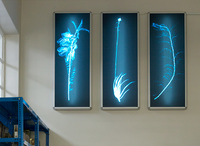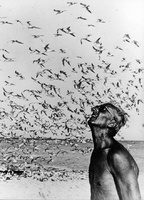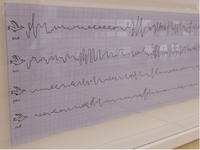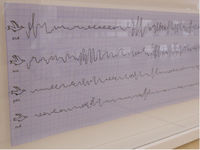Items
Site
The Medicine Chest
keywords is exactly
death
-

Planthology (detail)
“For 'Planthology (Bulbine frutescens and Lessertia frutescens)' I sourced two medicinal plant specimens from Kirstenbosch National Botanical Garden and x-rayed them at Groote Schuur Hospital (#10 and #13). These two local plants offer a wide variety of healing properties and address the lacuna of the chest. The fresh leaves of the Bulbine frutescens produce a jelly-like juice that can be used for burns, rashes, blisters, insect bites, cracked lips, acne, cold sores, mouth ulcers and areas of cracked skin, while an infusion of these leaves in a cup of boiling water can be taken for coughs, colds and arthritis (Harris 2003: online). The Lessertia frutescens is used as an immune booster in the treatment of HIV/AIDS, as a medicine in the treatment of chicken pox, internal cancers, colds, asthma, TB, bronchitis, rheumatism, rheumatoid arthritis and osteoarthritis, liver problems, haemorrhoids, piles, bladder and uterus problems, diarrhoea, dysentery, stomach ailments, heartburn, peptic ulcers, backache, diabetes, varicose veins and inflammation (Xaba & Notten 2003: online)” (Liebenberg 2021: 269). -

Planthology
In conversation with Dr Yeats in 2011 about adding a few medicinal plants to the centre as part of its displays, she mentioned that no plants survived in there. They all seemed to die from some mysterious cause. I decided to source three medicinal plants, the Lessertia frutescens, Bulbine frutescens and Artemisia afra, and X-ray them to 'diagnose' what might be the cause of their demise. In subjecting the plants to this process and placing the x-ray images in a space that foregrounds the diagnosis of human disease, I intended to create a heterarchical shift in this relationship, considering a world in which the degree of care directed toward human ailments might be replicated in treating diseases manifest in the botanical world. -

Second star to the right and straight on 'til morning
Cyanotype on paper. Ink on perspex. The work shows the exact positioning of the stars from J.M. Barrie’s window at 3 Adelphi Terrace, London (51°30'N 0°7'21"W), on Saturday, 19 June 1937 – the night of his death. Based on the direction of his window, I was able to locate the ‘second star to the right’ at the 45 degree angle he would have stood and viewed the night sky. Hopefully, he reached his destination, after departing the flat and traveling ‘straight on till morning’. -

The hut
Captain Scott writes in his den in the Terra Nova hut in this October 7, 1911. -

Whalesharks (Fiction/Fact)
Whale sharks (Rhincodon typus) are the largest shark, and indeed largest of any fishes alive today. These gentle marine giants roam the oceans around the globe, generally alone. They only feed on plankton. In the Norwegian explorer, Thor Theyerdal's account of his journey by raft across the Pacific Ocean from South America to the Polynesian islands in 1947, the crew is visited by one of these curious and benign creatures: "In reality the whale shark went on encircling us for barely an hour, but to us the visit seemed to last a whole day. At last it became too exciting for Erik, who was standing at a corner of the raft with an eight-foot hand harpoon, and, encouraged by ill-considered shouts, he raised the harpoon above his head. As the whale shark came gliding slowly toward him and its broad head moved right under the corner of the raft, Erik thrust the harpoon with all his giant strength down between his legs and deep into the whale shark’s gristly head. It was a second or two before the giant understood properly what was happening. Then in a flash the placid half-wit was transformed into a mountain of steel muscles. We heard a swishing noise as the harpoon line rushed over the edge of the raft and saw a cascade of water as the giant stood on its head and plunged down into the depths. The three men who were standing nearest were flung about the place, head over heels, and two of them were flayed and burned by the line as it rushed through the air. The thick line, strong enough to hold a boat, was caught up on the side of the raft but snapped at once like a piece of twine, and a few seconds later a broken-off harpoon shaft came up to the surface two hundred yards away" . -

Stevenson's fishing gear
A label accompanying Robert Louis Stevenson's fishing gear. -

A beating heart
"Dear Doctor Barnard I am an 11 year old girl, and I have a problem: I went fishing today; when we came back, my parents cleaned the fish, and after they took out the insides, they found a heart of a fish beating, but the fish was dead and cut up. It was still beating for about 1/2 an hour. Can you explain that? I am very interested in biology, and so is everyone else in my family. Sincerely Yours, Lillian Levy P.S. I know you are a very busy man, but, if you have enough time, please try to answer. THANK YOU! P.P.S. If a doctor says you're dead and they take out your heart but it is still beating, are you dead or alive?" Transcribed letter from the Heart of Cape Town Museum -

About Ed Ricketts
"Just about dusk one day in April 1948 Ed Ricketts stopped work in the laboratory in Cannery Row. He covered his instruments and put away his papers and filing cards. He rolled down the sleeves of his wool shirt and put on the brown coat which was slightly small for him and frayed at the elbows. He wanted a steak for dinner and he knew just the market in New Monterey where he could get a fine one, well hung and tender. He went out into the street that is officially named Ocean View Avenue and is known as Cannery Row. His old car stood at the gutter, a beat-up sedan. The car was tricky and hard to start. He needed a new one but could not afford it at the expense of other things. Ed tinkered away at the primer until the ancient rusty motor coughed and broke into a bronchial chatter which indicated that it was running. Ed meshed the jagged gears and moved away up the street. He turned up the hill where the road crosses the Southern Pacific Railways track. It was almost dark, or rather that kind of mixed light and dark which makes it very difficult to see. Just before the crossing the road takes a sharp climb. Ed shifted to second gear, the noisiest gear, to get up the hill. The sound of his motor and gears blotted out every other sound. A corrugated iron warehouse was on his left, obscuring any sight of the right of way. The Del Monte Express, the evening train from San Francisco, slipped around from behind the warehouse and crashed into the old car. The cow-catcher buckled in the side of the automobile and pushed and ground and mangled it a hundred yards up the track before the train stopped" (Steinbeck 1951: 279). After Ricketts' death in 1948, Steinbeck dropped the species catalogue from the earlier 'The Sea of Cortez' and republished it with a eulogy to his friend added as an afterword. -

Wave
Screengrab of an image search, typing in 'third wave' -

Vaal Bridge
The train crossing the Vaal bridge in the picture was the funeral train of Paul Kruger, the former president of the ZAR. He died in 1904 in Switzerland and his remains were taken to Pretoria. -

On the External Characters of Minerals
"The chest is designed to meet the requirements of travellers, miners, missionaries and others who need a chest of sufficient capacity to take a good supply of medicines without undue bulk and weight. It is very portable, and, on account of the material of which it is made, capable of standing hard usage" (BWC 1934: 24). -

The Sea Birds of Isabella
Aired between 1968 and 1976, 'The Undersea World of Jacques Cousteau' was a documentary television series about underwater marine life. It was directed by Alan Landsburg and hosted by French filmmaker, researcher, and marine explorer Jacques Cousteau. In the 33rd episode of the series, titled 'The Sea Birds of Isabella', the crew journeys off the coast of Mexico to an island to study its tropical birds. Three years after it was shown, Cousteau's son, Phillipe (then aged 38) died trying to land his seaplane, called the Flying Calypso, on the Taos River in Portugal. -

Flight
A chorus of juvenile heartbeats affected by Atrial Septal (ASD) and Ventricular Septal Defects (VSD), Patent Ductus Arteriosus(PDA), and Aortic Valve Stenosis (AVS), transposed to a higher frequency to simulate birdsong -

The Lost Boys
After they left Neverland, Mr and Mrs Darling adopted the Lost Boys. Before they had attended school a week they saw what goats they had been not to remain on the island; but it was too late, and they settled down to being as ordinary as “you or me or Jenkins minor” (Barrie 1989: 180). It is sad to say that the power to fly gradually left them. “At first Nana tied their feet to the bedposts so that they should not fly away in the night; and one of their diversions by day was to pretend to fall off buses; but by and by they ceased to tug at their bonds in bed, and they found that they hurt themselves when they let go of the bus. In time they could not even fly after their hats. Want of practice, they called it; but what it really meant was they no longer believed” ( Barrie 1989: 180-181). -

Avoided Object
Photographs of the sky above the Imperial War Museum taken with the camera that belonged to Hoess, commandant of Auschwitz -

On the External Characters of Minerals
"The chest is designed to meet the requirements of travellers, miners, missionaries and others who need a chest of sufficient capacity to take a good supply of medicines without undue bulk and weight. It is very portable, and, on account of the material of which it is made, capable of standing hard usage" (BWC 1934: 24). -

"I've decided to stop pitying myself"
“Her purse is half open, and I see a hotel room key, a metro ticket, and a hundred-franc note folded in four, like objects brought back by a space probe sent to earth to study how earthlings live, travel, and trade with one another. The sight leaves me pensive and confused. Does the cosmos contain keys for opening up my diving bell? A subway line with no terminus? A currency strong enough to buy my freedom back? We must keep looking. I'll be off now". An extract from Jean-Dominique Bauby's 'The Diving Bell and the Butterfly', the memoir which he dictated after suffering a stroke in 1995. The stroke rendered him mute and almost completely paralyzed, except for the movement of his left eyelid. Bauby dictated his memoir through blinking as his speech therapist listed the letters of the alphabet. When his doctor told him his prognosis, he mentioned that in the past , he would have simply died from this type of stroke, but that improved resuscitation techniques had now prolonged and refined the agony of this condition: "You survive, but you survive with what is so aptly known as 'locked-in syndrome'”.


